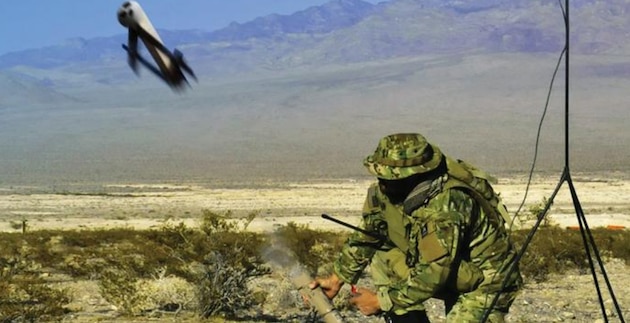They usually come at night. Residents of Ukrainian cities repeatedly hear the impact of Russian kamikaze drones. The expression is actually misleading: During the Second World War, kamikaze attacks were suicide attacks by young Japanese pilots who threw their planes at Allied ships in order to cause as much damage as possible. The death of the pilot was part of the concept.
But drones are unmanned. One could speak of a disposable drone because the drone is destroyed during the attack – in contrast to the Turkish Bayraktar drone, for example, which returns from its bombing and reconnaissance flights.
The kamikazed drone used in Ukraine is mostly an Iranian-type Shahed-136 combat drone – although both Russia and Iran still deny the purchase to this day.
The Shahed-136 is approximately 3.5 meters long and has delta wings with a wingspan of approximately 2.5 meters. It can carry around 50 kilograms of explosives. The drone is powered by a rear pusher propeller with a petrol engine.
It is correspondingly loud, the speed of almost 200 km/h rather low. However, the range is given as up to 2000 km.
Even if these are Iranian manufacturer specifications and the range should be a little shorter, that would be extremely long compared to other kamikaze drones. Any Ukrainian city can be hit from Russia with the Shahed-136.
However, the Shahed-136 is very simply constructed. In contrast to the American switchblade (switchblade), for example, a target is entered beforehand with the Shahed, which must be fixed, which the drone then controls automatically. Once the destination has been entered, it can no longer be influenced.
Kamikazed drones are also called “loitering weapons”. In contrast to the Shahed, other systems such as the Switchblade first hover over an area of operation before an operator on the ground assigns them a datalink to a target, which can also be mobile. The drone steers toward it, destroying itself in the process.
The Shahed doesn’t stand a chance against modern anti-aircraft systems. According to military experts, the drone is also hardly suitable for use at the front. But that doesn’t seem to be the aim of the Russian military in the Ukraine war either.
The tactics used are apparently different: they are intended to hit civilian targets such as supply facilities and residential buildings and spread terror among the population.
Because the drone is comparatively cheap, costing around $20,000 each, and its components are easy to obtain, defenders often face the difficult question of whether it is worth using the most modern anti-aircraft missiles against them when each one costs many times that of a kamikaze drone can.
Especially since Russia often deploys swarms of Shaheds in Ukraine, some of whom are shot down, but others achieve their goal. In addition, defending against the drones ties up the Ukrainian military and air defense all over the country, which is then missing at the front. That too seems to be a Russian calculation.
Western military experts also suspect that the kamikaze drones are used as a replacement for the much more expensive cruise missiles, which are apparently becoming scarce in Russia.
The simple, cheap kamikaze drones play practically no role on the battlefield. But Russia is apparently not least relying on their psychological effect: wearing down the civilian population.
Author: Christoph Hasselbach
This year, Putin gave his New Year’s speech surrounded by soldiers. But Twitter users were taken aback and recognize some faces from past propaganda videos. Above all, one woman always appears – in completely different roles.
Six armed Wagner mercenaries escaped from a training camp in the Luhansk region on Friday. The fugitives are probably prisoners recruited by Wagner financier Yevgeny Prigozhin in Russian prisons. Rostov-on-Don residents are urged to exercise caution.
The original of this article “Russia is increasingly using kamikaze drones” comes from Deutsche Welle.
